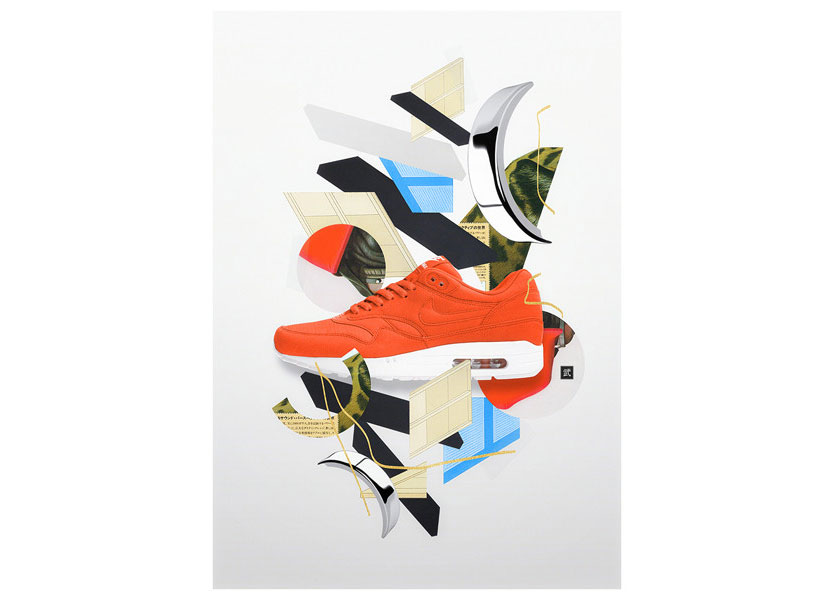French-born, New York-based artist and illustrator Emeric ‘Takeshi’ Trahand is renowned for his supreme visual skill and signature use of popping colour and photomontage, which have earned him commissions from the likes of Nike, Adidas or Swatch, to mention just a few. DASH was fortunate to feature his original artwork as part of the current ‘Transformation’ Spring / Summer 2014 issue and has caught up with him for a little chat.
Emeric, your personal cargo collective is titled ‘Still On The Run’. Can you tell us who or what you’re running from or to?
I’m a mercenary – I sell my skills. I’m running away from similarity and lack of character; running from a job to another, without ever settling down.
You’re originally from Saint Etienne in France, but have come to reside in the Big Apple. How has this move shaped you as an artist and designer?
New York is a powerful place. It pleases you, burns you, changes you for better and worse. It’s a lot about its pace, its lights, the idea that it’s the centre of something. Leaving everything behind you and starting life over in a different place shapes you as a human being, and its undeniable that this move to New York has affected me deeply as an artist, too. It changed my perspective on time and space, allowed me to meet the right people, get closer to the jobs I wanted to get. All this combined definitely made me a much more accomplished artist, commercially at least.
How do you define the relationship between technical skill and creativity in your work?
As far as technical skill is concerned, I believe in exploration and challenge. I don’t want my art to be defined by its limitations. My latest works are undeniably technically simple compared to what I used to be known for. I use simpler shapes and compositions. This doesn’t mean the process is simpler though. On the contrary, working with less artifice necessitates more precision and taste in what is being used. After years of being sidetracked by manufactured technical tricks, I try to focus on something more pure and essential, like a basic effort on composition, tones and materials.
Do you approach commissions for big name companies differently than when working on smaller editorial projects?
What really matters is the project, the idea, the possibility of expressing beauty. I approach commissions depending on that, rather than caring too much about who the client is. It’s a lot about sincerity toward the craft first.
How do you strike a balance when complying with a client’s brief without compromising your own integrity as an artist?
The notion of the ‘client’ is by essence a compromise to an artistic vision. The reality is a tenuous equilibrium between commercial realities, client expectations, actor’s egos, and a tiny bit of genuine will to make something pretty. It takes practice and a lot of abnegation.
What’s your deciding factor when accepting or passing on a commission?
I pretty much only need to see that we are gonna be able to make something beautiful and hopefully never seen too often before. I’m trying to stay away from the state of copy and repetition in which some agencies are stuck.
Your portfolio of clients is incredibly diverse comprising musicians, music labels, fashion brands, even the Grand Prix de Montreal. What – do you feel – makes your work so widely appealing and commercially viable?
I work a lot. I have done ever since I started eight years ago. I always try to produce the best I can at any given moment, spending a lot of time and energy trying to define a personal vision. I think that’s what makes the difference.
Collage / montage and striking colour combinations feature heavily in your work. Can you talk us through your process of de- and reassembly?
I mostly work with elementary, flat collages of photos from materials I’ve gathered over the months. It can be pieces of magazines, books, posters, papers, postcards, anything with a graphic aspect to it can become building material. I feed a lot from random finds on the internet, too. I mix a hand-crafted process of cutting and gluing with digital composition. I try to only use the computer as an extension of what I would do with my hands, and stay away from too many tricks, special effects or treatments. I’m mostly looking for the imperfection of hand-made work – it has a unique warmth and appeal to me.
What, other than deadlines, gives you the feeling that a piece of work has been finished?
After working on images for all these years, there is a big part of the process that is performed unconsciously. Some deep automatism. I guess my brain will do this part for me. I’m not sure why, but I just know when it’s done.
Is there anyone (brand, company or other) you would literally drop anything else for if commissioned to do a piece for them?
I’m viscerally attracted by larger scales – artworks living in a space – rather than on a screen or print-out. I wouldn’t drop everything for a client, but would definitely give my attention to any client that wants to do larger-scale works.
Interview: Harald Weiler












